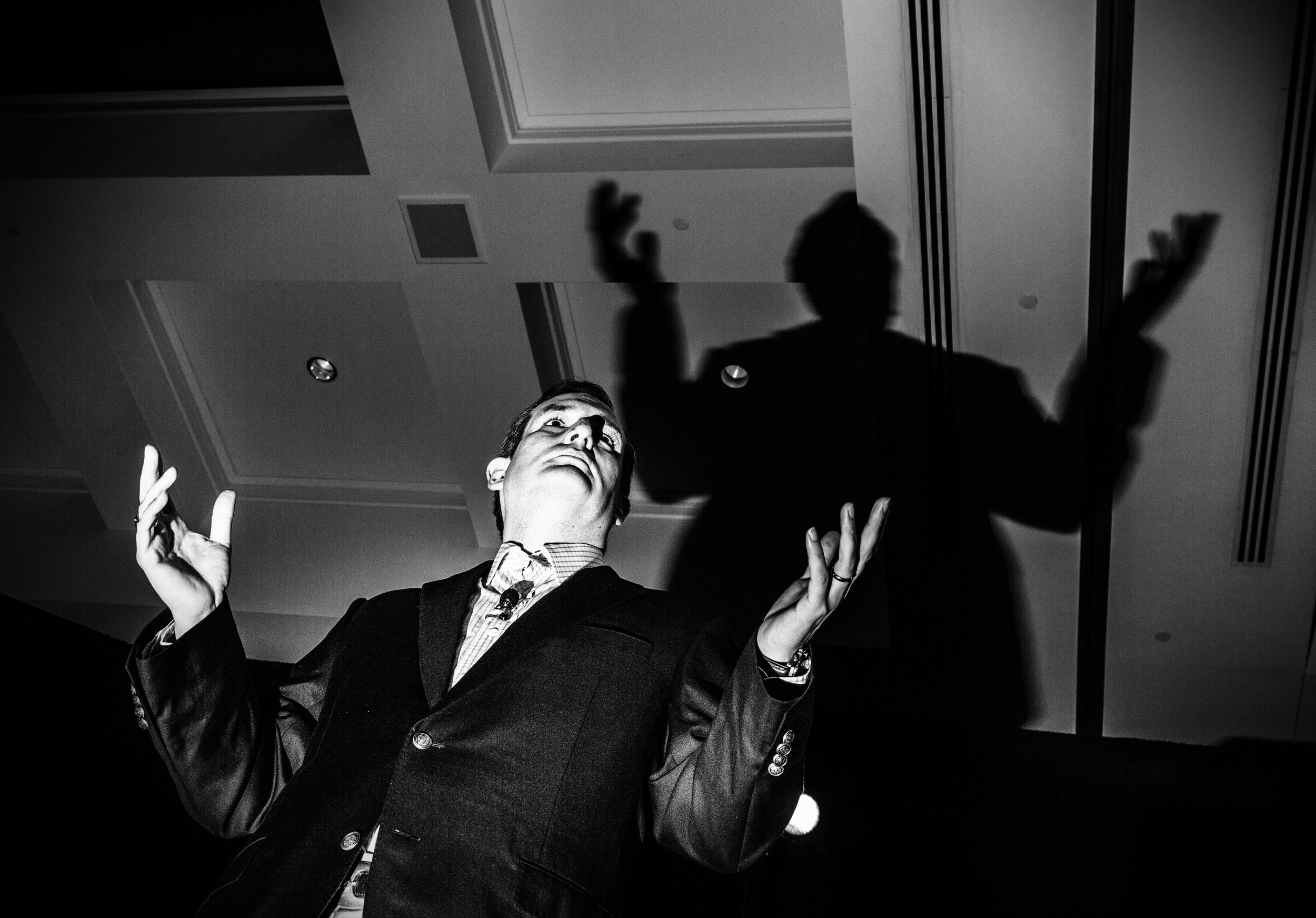By Jim Colton
“Seeing is not enough; you have to feel what you photograph.” – Andre Kertesz
I love looking at photographs, especially those that have people in them, that were taken with a wide angle lens. You know the ones I’m talking about….the ones that make you feel like you are actually in the room with them…a part of their conversation.
To make those kinds of images successfully, it takes a certain skill set including, sensitivity, timing, and your very own unique view of the world. Sometimes you have to be a fly on the wall, other times you have to be the paint on the wall that the fly lands on; and every once in a while, you have to be the fly swatter! And it takes a honed mind and a seasoned eye to know which approach to take.
Mark Peterson
Few people have used this “up-close-and-personal” approach better than Mark Peterson.
Peterson certainly has developed a style. His images have an intensity to them that can’t be achieved with mid-range or long lenses. And it’s a style that has suited him well over the years with clients that wanted someone who would bring “something different” to the table. I once assigned him to a college football game knowing full well, that I wasn’t going to see a single action picture when it came time to edit. And the results did not disappoint.
Peterson was born in Minneapolis but has spent most of his adult life in the New York City area. His work has been published in TIME, Newsweek, Sports Illustrated, ESPN the Magazine, the New York Times Magazine, New York Magazine, Fortune and GEO to name a few. He’s been the recipient of several awards including the Eugene Smith fellowship grant for his work on revolving door alcoholics. He’s had numerous exhibitions and museum shows including one at the Louvre in 2012. He is the author of “Acts of Charity,” a Powerhouse book, and is represented by Redux Pictures.
Peterson is currently killing it with his coverage of the political scene. Each picture he publishes is better than the last, leaving me drooling for the next image from a political zoo that resembles an Orwellian dystopia; Animal Farm 2016! This week, zPhotoJournal has a candid conversation with the talented and unique Mark Peterson.
Jim Colton: Tell us a little about the road from Minneapolis. How did it all start? At what point did photography become your calling?
Mark Peterson: I was about 25 when I decided I would try photography. I had failed at everything else in my life (I’ve worked in a casino in the Nevada desert during the summer, was a ski bum in Utah during the winter, worked selling things door to door, worked as a bar tender at a disco, and worked in a warehouse unloading box cars of dog food.) So I thought photography would be easy…that was my first mistake.
I was lucky enough to work for the alternative paper in Minneapolis called the City Pages and also to work for UPI as a stringer and then a staffer. I came to NYC in 1987 thinking I could freelance for magazines and at a 500 dollar day rate, I would only have to work one or two days a month to make ends meet. That was my second mistake. I am now with Redux Pictures (See link below) and am very lucky to be with such a great agency.
Brooke Astor: White gloves up to her elbows. © Mark Peterson/ReduxPictures for the New York Times Magazine
JC: You worked as a freelance photographer during the heyday of photojournalism for magazines and newspapers. What were some of your favorite early assignments?
MP: One of my first assignments was for the New York Times Magazine, photographing Brooke Astor, the head of New York Society. I followed her around for several days. It was a world I had never seen before. One day we went to an elementary school in Harlem that Astor had given money to for library books. She was dressed in a Chanel dress with white gloves up to her elbows. The students looked at her like she was from Mars.
This led me to my project about charity which I worked on for 10 years and the book by Powerhouse Books, “Acts of Charity.” (See link below) I found it slightly obscene that people in NYC had lavish parties where they dressed up and ate and danced in the belief that they were helping the poor, the homeless and the sick.
JC: I've had the pleasure of working with you in various capacities from news to sports. Neither, I would dare to say, in a conventional sense. For example, when you covered the Army/Navy game for me at Sports Illustrated, I went into it knowing that I wasn't going to see, nor would I ask you to take...an action picture. Do you remember that assignment? Are those the best ones, where you have a little artistic freedom?
The annual Army/Navy football game. © Mark Peterson/ReduxPictures for Sports Illustrated
MP: Yes, I valued your trust in me as a photographer. It’s great to have that freedom to try and see things that I find interesting at an event and hopefully that translates to the wonder of it for the viewer. Sometimes when you’re given a shoot list and too much direction you become mired in “filling” it and don’t see the unique moments that are transpiring.
JC: You have a very unique perspective when you shoot. Many of your stories are "up close and personal," with wide angle lenses, making us feel as if we are actually IN the photograph when we see it. Can you describe that process a little bit for us? What is your favorite camera/lens combo? What else might be in Mark Peterson's camera bag?
MP: I like a lot of chaos in my pictures. I do like to be close to the action. It gives me a feeling of what is happening. I think I started working this way because I use flash so much for my pictures and I like the foreground to pop in the frame. I am married to my 24mm lens and my Canon camera and flash.
Donald Trump at the Freedom Summit in Des Moines, Iowa. © Mark Peterson/ReduxPictures
JC: Your current series "Politics in Black & White" is brilliant! You are quite well known for your use of color...so why Black & White? Are you shooting in B&W or Color and then converting? What post treatments are you using (if any) including apps or prep for Instagram?
MP: I am shooting in color and then I process them in Photoshop and turn them into B&W. At the start, I used an iPhone app to process them, but now I use Photoshop and I like this better. The reason I started doing these pictures in B&W was when I looked at them in color, they looked too real or ordinary. To me they didn’t reflect the political theater that these events were really about. The speeches and rallies are not organic events. They are orchestrated for the media and I wanted to accent this political theater and black and white seemed to do it best.
JC: Some of your work shows politicians in, shall we say, a less than flattering manner...because of the harsh light, angles, extreme close-ups, etc. Do you consider this as being part of your "style?" And does it bother you that some might think it is casting an editorial judgement on your images? Do you even think about stuff like this (editorial approach) before you cover an assignment?
Scott Walker on the campaign trail in Philadelphia. © Mark Peterson/ReduxPictures
MP: I think every time I push the shutter I am making an editorial judgement.
JC: As someone who has transited analog to digital...what do you miss...and what do you not? What would you like to see being done differently in today's publishing world? And how important is social media to you as a professional tool?
MP: I think we are living in one of the greatest times in photography. I see more great photographers and more great work now because of the internet and social media. I like Facebook and Instagram as a way to show my work. And even more to see what others are doing.
Facebook is like a town square when people shout out what’s going on. And Instagram is like looking at people's proof sheets of what they're working on. I feel very lucky to be a part of the photography community and to work with such great people.
JC: Do you have any long or short term projects on your agenda? Are there any books or ideas for books in the works?
MP: I am working on the "Politics in Black & White" and will go through the election cycle on it.
Nature Calls: A break during a 2nd amendment rally in Washington DC. © Mark Peterson/ReduxPictures
JC: Do you have any final thoughts that you would like to share with our readers....and/or...any sage wisdom/advice that you can impart to young photographers who are contemplating a career in photojournalism?
MP: When I first came to NYC in the late 80’s I remember being at a table with a group of photographers who I greatly admired. They were all talking about how photography was dead...that magazines were finished. I think you hear a lot of that again today and I would say if you love photography don’t listen to anything but the sound of the shutter.
* * *
LINKS
Mark Peterson: http://www.markpetersonpixs.com/
Redux Pictures: http://www.reduxpictures.com/
“Acts of Charity”: http://www.amazon.com/Acts-Charity-Mark-Peterson/dp/B005Q63UYQ
Facebook: https://www.facebook.com/mark.peterson.7739814?fref=nf
Instagram: @markpetersonpixs
Twitter: @petersonpix
-----------------------------------------------------------------------------------------------
DO YOU HAVE A STORY YOU THINK IS A GOOD CANDIDATE FOR ZPHOTOJOURNAL? EMAIL YOUR SUGGESTION TO: JIM.COLTON@ZUMAPRESS.COM
Jim Colton
Editor www.zPhotoJournal.com
Editor-at-Large ZUMAPRESS.com
jim.colton@zumapress.com

















